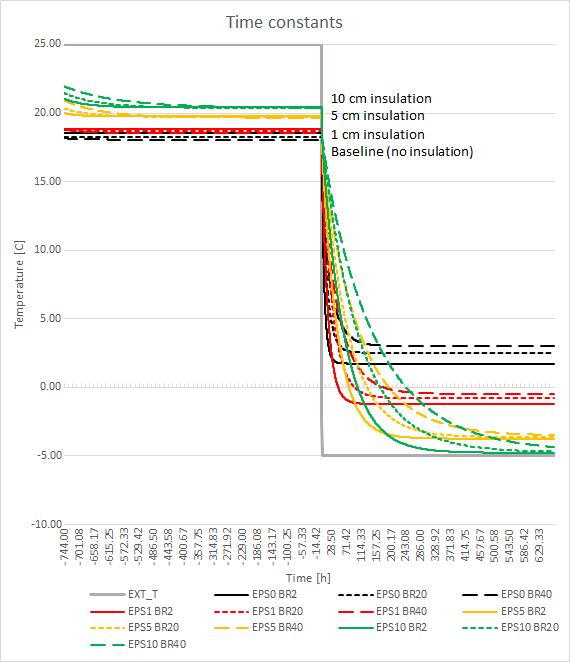So I was trying out a simulation with a custom made EPW to evaluate the thermal resiliency of a building: upon a dramatic change in ambient temperature I want to look at how much time passes before the internal temperature drops 63% before settling to a final temperature (essentially a time constant for thermal lag evaluation).
- Through Ladybug Tools I modeled a simple and unconditioned 100 m2 house, I removed every possible heat gain from its program. I made 12 variations with changing EPS thickness (0, 1, 5, 10 cm) and brick thickness for both internal and external walls (2, 20, 40 cm).
- Through Elements I wrote a custom EPW with no global nor direct nor diffuse radiation, no infrared sky radiation, no wind. All of January sits at a steady 25 C, then February suddenly changes to a steady -5 C (30 C temperature drop). Relative humidity is steady 50% for both months. My simulation is only 2 months long so the rest of the year is not important.
- I simulated the house model with differing insulation and thermal mass levels. I'm interested in looking at the zone temperature changes after the aforementioned ambient drop in temperature.
Here comes the unexpected part. I was expecting for the initial temperatures to be much closer to 25 C, and the final ones to be closer to -5 C, instead every single case had a differing temperature. For the inital stage I thought that some heat is radiation out into the sky, which would make sense, since the baseline with no insulation (black line in graph below) experiences a lower zone temperature, however the same case also settles at a much higher temperature than the case with the higher insulation thickness (green line). I tried further increasing the insulation thickness and got temperatures that go even lower than outdoor temperature. For extra information, the sky temperature is 10.99 C in January and -23.61 C in February.
Please help me understand what is happening. Here are both the IDF and the EPW files.





